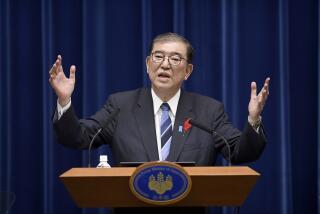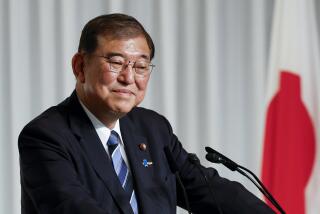Kaifu Picks Cabinet Free of Scandal Taint : Japan: He retains the key finance and foreign ministers as he prepares to meet President Bush. Two women are dropped to restore an all-male lineup.
- Share via
TOKYO — Just two days before he leaves for an urgent summit meeting with President Bush, Prime Minister Toshiki Kaifu asserted himself today by naming a new Cabinet free of scandal-tainted ministers but also dumped the two women in his old Cabinet, reverting to an all-male lineup.
Two key ministers, Foreign Minister Taro Nakayama and Finance Minister Ryutaro Hashimoto, were retained despite efforts by strongmen of the ruling Liberal Democratic Party to have them replaced. A former agricultural minister, Kabun Muto, was named to the important post of minister of international trade and industry.
All three key ministers were scheduled to meet today to discuss a tentative Japanese position on economic issues for the Palm Springs summit with Bush. Only Nakayama, however, said he will accompany Kaifu on the trip.
The Foreign Ministry announced Tuesday that Kaifu will meet Bush on Friday night and Saturday morning and leave Palm Springs in mid-afternoon Saturday to return to Tokyo.
Kaifu won election as prime minister Tuesday from both chambers of Parliament--the opposition-controlled upper house endorsed him after two center parties abstained--and immediately began work on his new Cabinet. But he had to struggle through nearly nine hours of wrangling with the powerful factional leaders of the Liberal Democrats to win approval for his Cabinet.
The new ministers started arriving at the prime minister’s office after 1 a.m. to receive their appointments. Press conferences by each of the 20 appointees continued one after another until 2:43 a.m.
More than six hours were spent persuading Michio Watanabe, the new leader of the faction that had been led by former Prime Minister Yasuhiro Nakasone, to drop his insistence that Takayuki Sato, a former vice minister of transportation, be named to the Cabinet.
Sato was convicted of accepting a $6,667 bribe paid in 1972 with funds supplied by the Lockheed Corp. in a scandal that came to light in 1976. He was fined the amount of the bribe and given a suspended two-year jail sentence in 1982.
Earlier, insisting on upholding a campaign pledge to carry out political reform, Kaifu told the party’s five faction leaders that he would refuse to appoint politicians who had received favors from Recruit Co., an information and real estate conglomerate at the core of an influence-buying scandal.
Exclusion of scandal-tainted leaders, however, left the party’s most significant strongmen--Watanabe, former Foreign Minister Shintaro Abe, and former Finance Minister Kiichi Miyazawa--unfettered by Cabinet discipline and free to snap at Kaifu’s ankles.
Kaifu, a lieutenant of the weakest faction in the ruling party, was named prime minister in a “dark horse” compromise last August after scandals and an upper house election defeat forced two of his predecessors to resign within three months of each other.
Unlike his first Cabinet, to which Kaifu appointed two women, the new group reverted to the traditional all-male composition. Kaifu brushed aside protests from Chief Cabinet Secretary Mayumi Moriyama and named a man, Misoji Sakamoto, to replace her.
The chief Cabinet secretary is in charge of coordinating all government ministries and dealing with opposition parties--skills Moriyama was widely regarded as lacking.
Kaifu apparently made an effort to retain his female Economic Planning Agency director, Sumiko Takahara, but was unable to win approval from the faction leaders.
In a news conference today, Kaifu said he could not appoint any women because of a need to balance Cabinet posts among the party’s factions.
More to Read
Sign up for Essential California
The most important California stories and recommendations in your inbox every morning.
You may occasionally receive promotional content from the Los Angeles Times.










